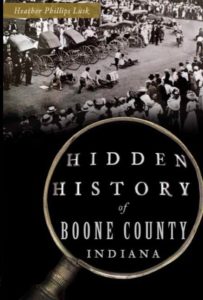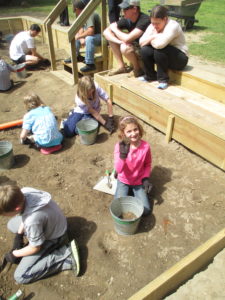I recently completed a book – my first – based on county history. Hidden History of Boone County has some basic history to set the tone, then delves into plenty of new information. Each time I shared information with a historian or long-time resident that was something new to them, I felt an enormous sense of pride. 
In a figural sense, I had to dig up the past by looking through old newspapers and magazines, combing through files of information. It was like someone took a hundred puzzles of all different shapes and sizes, dumped all of the pieces on the floor and mixed them all together. Then it was my task to put just one of them together with someone describing to me what the puzzle looked like.
Sometimes I would find puzzle pieces already connected, left by someone who had tried on their own to put the puzzle together. Writers for the Boone County Magazine, published in the 1970s, had the benefit of interviewing many people while they were still alive, capturing their stories before they disappeared.
In a few instances the pieces are still missing. A quarter of the county was once a Native American reservation. The Eel River Band, a part of the Miami Nation, lived on the land for several decades at minimum before being driven out of the state in 1846. While I was able to put together more of that puzzle than I should have expected, there are still many holes of missing pieces that may never be discovered.
It wasn’t easy but it was a lot of fun. Learning about the past, learning about the history and how we got here fascinates me. I now have a renewed appreciation for those who put history together on a professional level.
A Big Dig
Over the past week I’ve come across two items that show how vastly different the processes for recording history can be. In a neighboring county, a burial site for the Miami Nation was desecrated by archeologists in the hunt to literally dig up the past. I was heartbroken reading this article, knowing that the unearthed community called Strawtown has a connection to Boone County. A well-traveled road lies between the reservation’s former location and Strawtown, and it’s rightly assumed that the people from each community would have frequented it. Other trails were difficult to find, but this one was so evident that it eventually became a county road. 
Even being curious about the real stories behind these burial places, I can’t fathom simply taking a shovel and discovering the answers for myself without contacting the relatives of those who are deceased. In Boone County, a plaque honors two fallen Miami Chiefs who stabbed one another at the same time, angered about a treaty to lose their land. They each died instantaneously, according to legend. In truth, the names on the plaque lived for many years beyond that according to Miami records. One of them certainly didn’t live in Boone County, the other may have.
It begs the question whether they are truly buried there, or if it was a story concocted by the first settlers in the area to justify taking the land from people who would kill one another. But is finding the answer worth desecrating a grave?
The quest for knowledge doesn’t have to be damaging. In Washington state, a Native American community was discovered and subsequently unearthed in a very different manner. A Makah village called Ozette had been buried by a mudslide and then time, with some parts dating back 2,000 years. Tribal members and archeologists worked in tandem to excavate the community in a beautiful partnership that could only have benefitted both. It’s a tremendous way of respecting the past while including the present and certainly gave researchers more information than if they’d unearthed items on their own, in a vacuum.
A Kid Dig
One thing that struck me from the excavation in Strawtown is the use of children in archeology. Many years ago we visited Williamsburg and they had a special program for youth to participate in a dig. Because the site had been previously excavated in the mid-20th century and new construction built on top, this basically compromised anything left beneath from an archeological perspective. It would be impossible to know if an item had always been in that spot – like a dozen pipes – indicating the area was used for something specific, or if they had been moved during construction. 
Kids were able to try their hand at excavation without actually ruining the work of experts. It was the ideal scenario. The experts at the location noted that such an experience was very rare, and wouldn’t be possible at a newly discovered site. Not only is there the matter of carefully preserving what’s beneath, there’s also no risk of compromising something sacred to others. On occasion the junior archeologists unearthed bones but only from a dog, chicken or fish.
My research about the Eel River Band, my conversations with members of the Miami and simply standing before a memorial of a Native American burial site not far from where I live gave me a connection and appreciation for what is undiscovered. Sometimes it’s okay not to dig up the past. Sometimes those items should remain beneath the surface until the time is right.